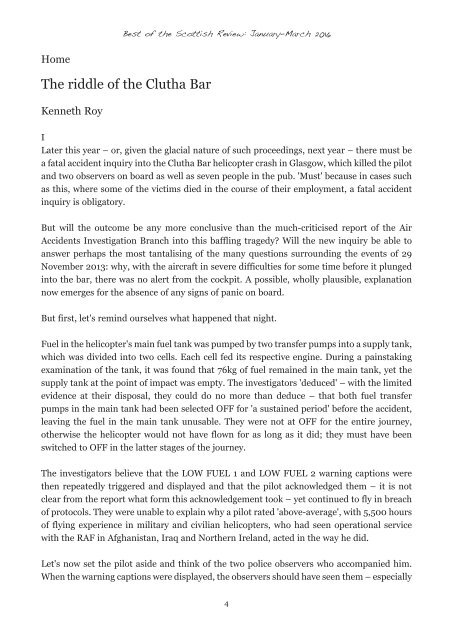Scottish Review
SRanthology01-03-16
SRanthology01-03-16
You also want an ePaper? Increase the reach of your titles
YUMPU automatically turns print PDFs into web optimized ePapers that Google loves.
Best of the <strong>Scottish</strong> <strong>Review</strong>: January–March 2016<br />
Home<br />
The riddle of the Clutha Bar<br />
Kenneth Roy<br />
I<br />
Later this year – or, given the glacial nature of such proceedings, next year – there must be<br />
a fatal accident inquiry into the Clutha Bar helicopter crash in Glasgow, which killed the pilot<br />
and two observers on board as well as seven people in the pub. 'Must' because in cases such<br />
as this, where some of the victims died in the course of their employment, a fatal accident<br />
inquiry is obligatory.<br />
But will the outcome be any more conclusive than the much-criticised report of the Air<br />
Accidents Investigation Branch into this baffling tragedy? Will the new inquiry be able to<br />
answer perhaps the most tantalising of the many questions surrounding the events of 29<br />
November 2013: why, with the aircraft in severe difficulties for some time before it plunged<br />
into the bar, there was no alert from the cockpit. A possible, wholly plausible, explanation<br />
now emerges for the absence of any signs of panic on board.<br />
But first, let's remind ourselves what happened that night.<br />
Fuel in the helicopter's main fuel tank was pumped by two transfer pumps into a supply tank,<br />
which was divided into two cells. Each cell fed its respective engine. During a painstaking<br />
examination of the tank, it was found that 76kg of fuel remained in the main tank, yet the<br />
supply tank at the point of impact was empty. The investigators 'deduced' – with the limited<br />
evidence at their disposal, they could do no more than deduce – that both fuel transfer<br />
pumps in the main tank had been selected OFF for 'a sustained period' before the accident,<br />
leaving the fuel in the main tank unusable. They were not at OFF for the entire journey,<br />
otherwise the helicopter would not have flown for as long as it did; they must have been<br />
switched to OFF in the latter stages of the journey.<br />
The investigators believe that the LOW FUEL 1 and LOW FUEL 2 warning captions were<br />
then repeatedly triggered and displayed and that the pilot acknowledged them – it is not<br />
clear from the report what form this acknowledgement took – yet continued to fly in breach<br />
of protocols. They were unable to explain why a pilot rated 'above-average', with 5,500 hours<br />
of flying experience in military and civilian helicopters, who had seen operational service<br />
with the RAF in Afghanistan, Iraq and Northern Ireland, acted in the way he did.<br />
Let's now set the pilot aside and think of the two police observers who accompanied him.<br />
When the warning captions were displayed, the observers should have seen them – especially<br />
4


